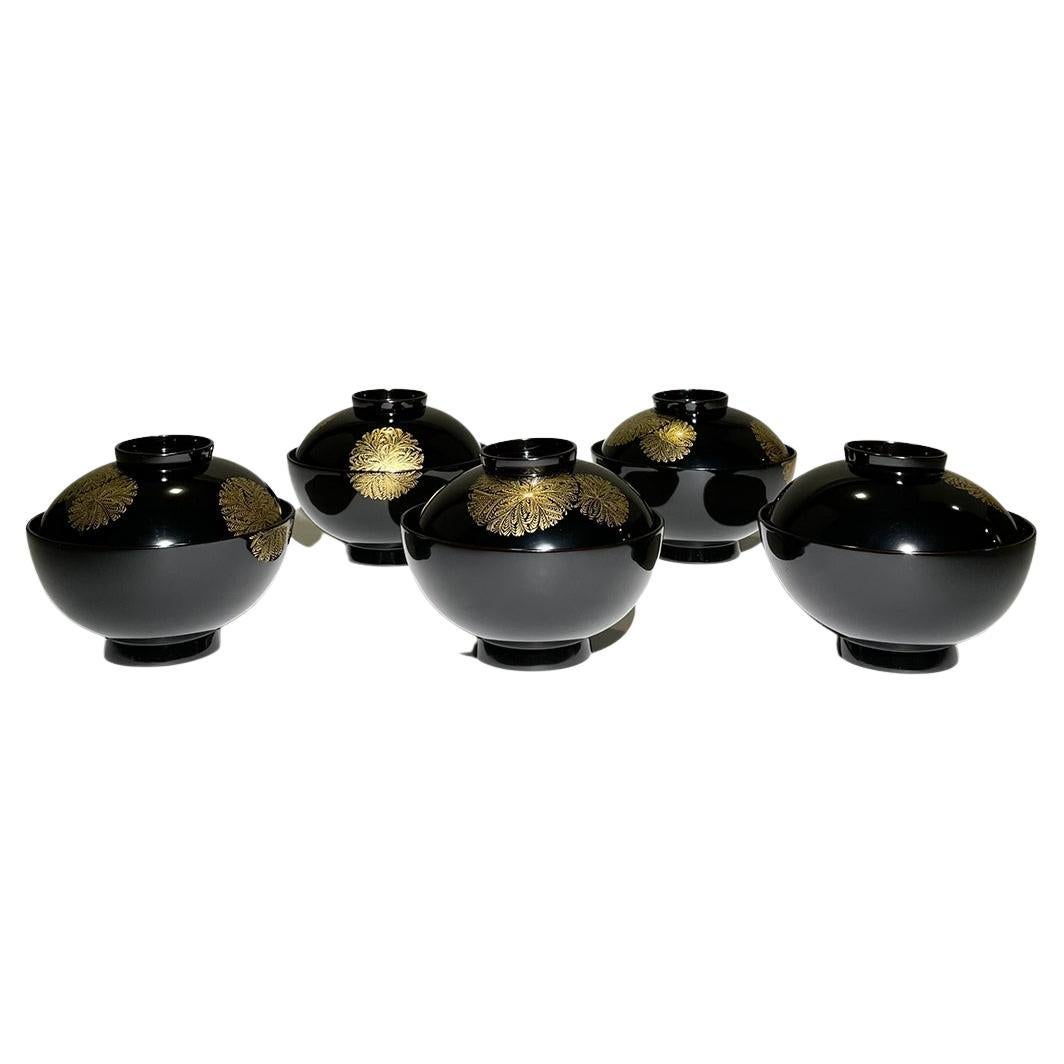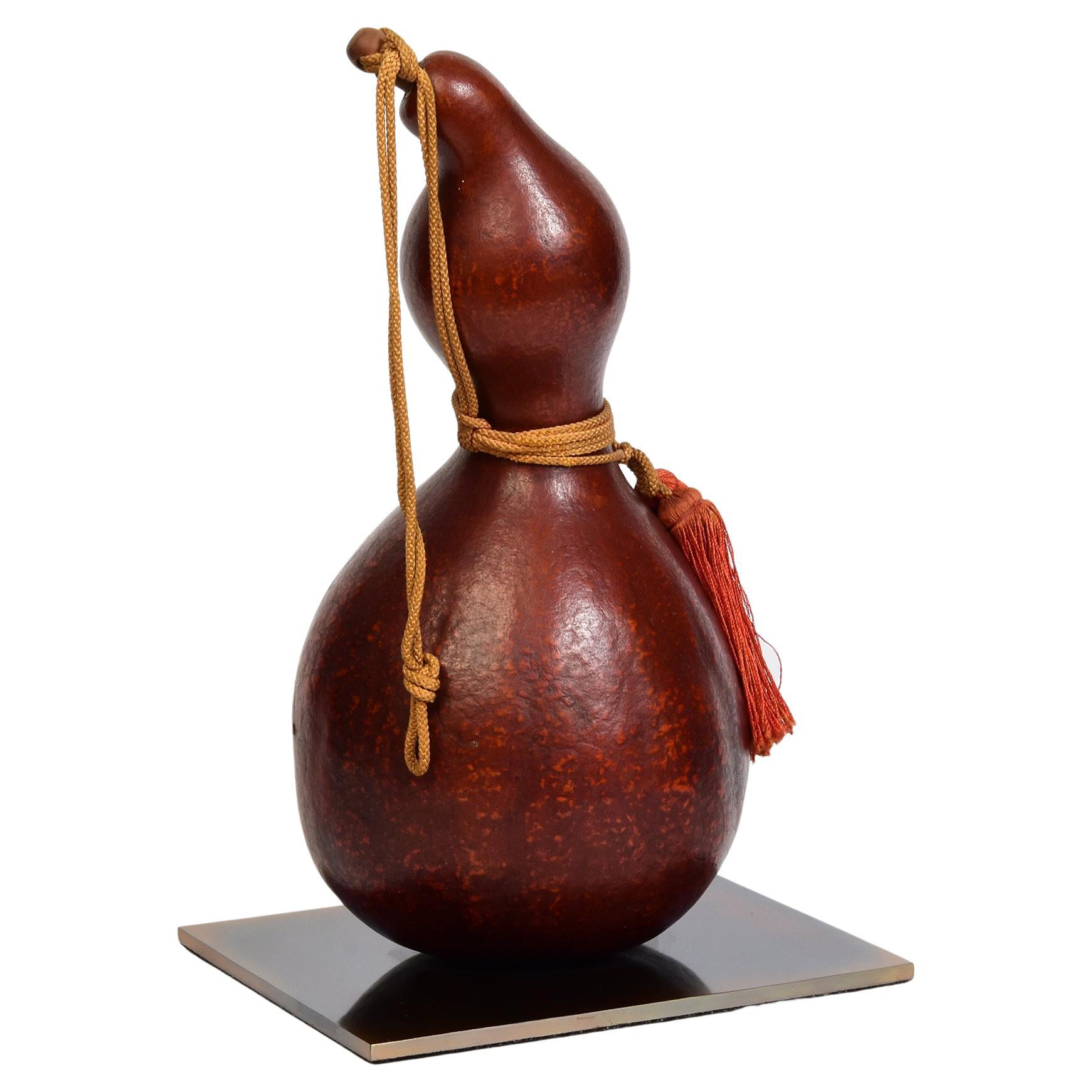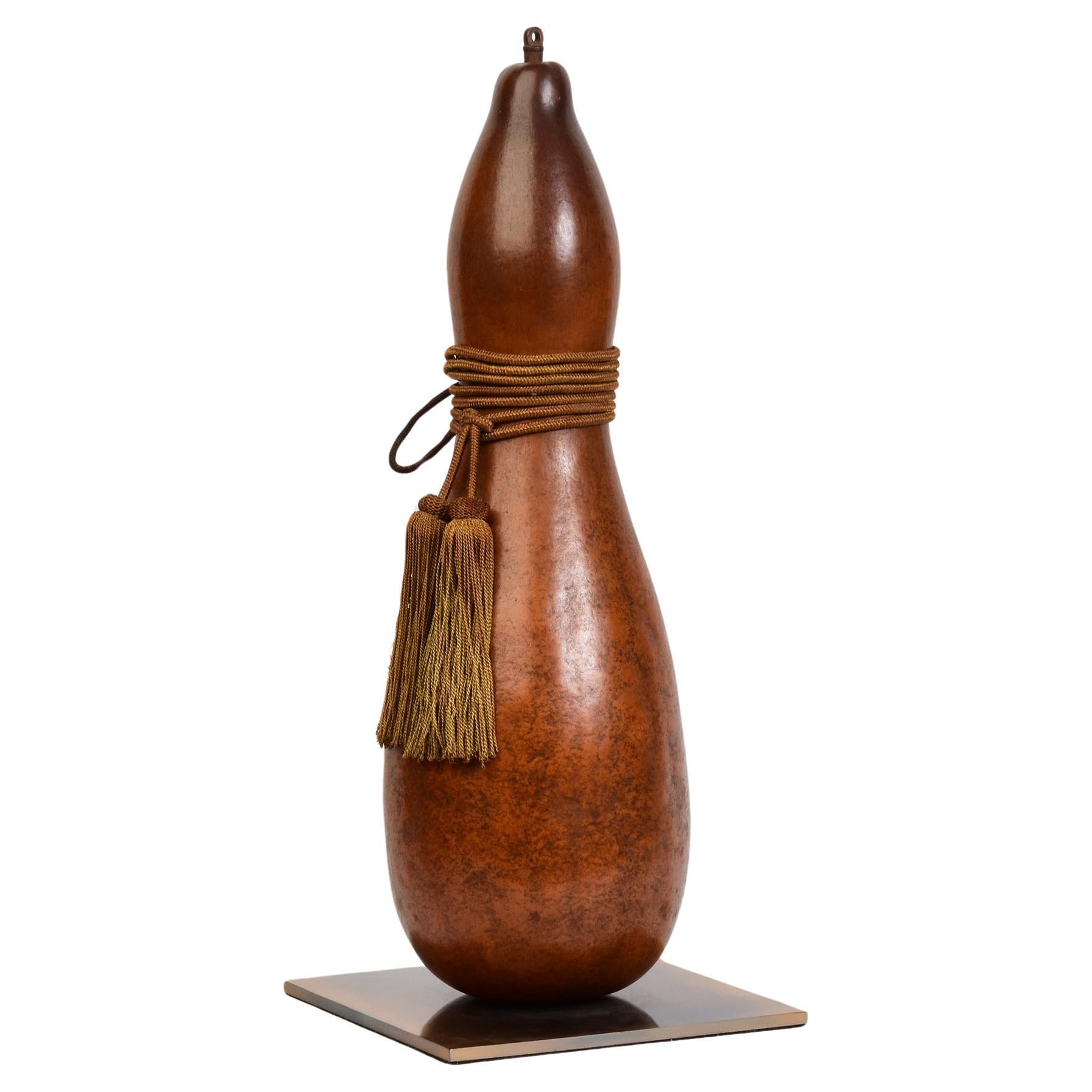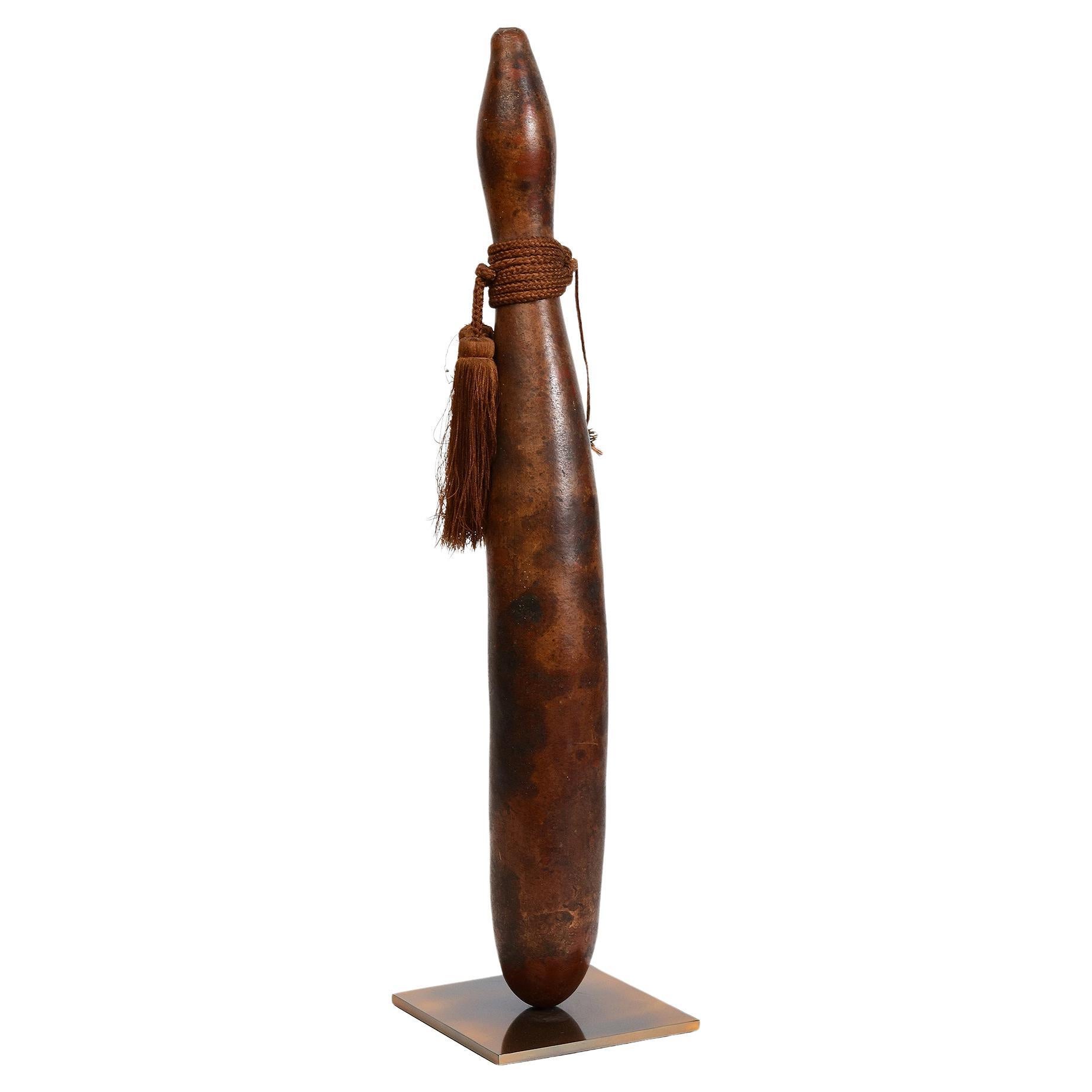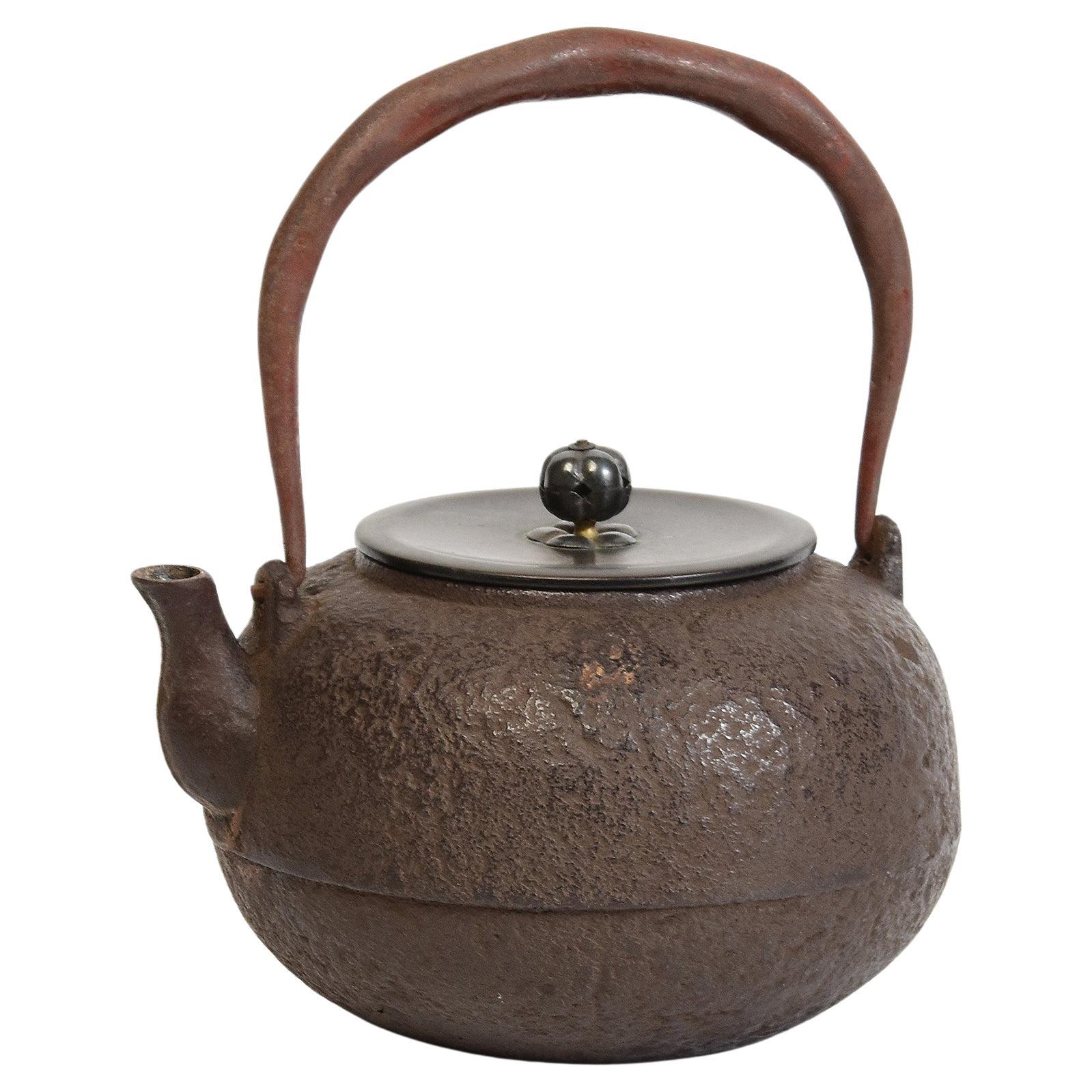Items Similar to Pair of Japanese cast iron chôshi 銚子 (sake kettles) with lacquered lids
Want more images or videos?
Request additional images or videos from the seller
1 of 19
Pair of Japanese cast iron chôshi 銚子 (sake kettles) with lacquered lids
About the Item
Pair of enticing cast iron chôshi (sake kettles) with a detailed lacquered lid, raised by three low feet. Its rotund body with a subtle embossed design of stylized symbols, like mythical creatures in cartouches, Buddhist flames and chrysanthemum flowers (kiku). Finished with a rim of scrolling foliage.
The black lacquered lids with golden hiramaki-e (low-relief lacquer design) and
togidashi maki-e (burnished lacquer design) depicting flowering chrysanthemums surrounded by leaves.
Surmounted by a silver knob shaped like a kiku as well.
The loop handle with a subtle silver inlay design of scrolling vines and reticulated ovals.
Approx. dimensions:
Height with handle 7.08 in/18 cm, Height 3.93 in/10 cm.
Including original wooden tomobako (storage box) with dated inscription: ‘The 12th year of the Bunsei period (Bunsei Nijyû’nen), which is Anno 1829. Once part of the collections of the Nomura family.
When shipped we will add a certificate of authenticity.
Price including insured shipping.
- Dimensions:Height: 7.09 in (18 cm)Width: 8.67 in (22 cm)Depth: 6.89 in (17.5 cm)
- Sold As:Set of 2
- Materials and Techniques:
- Place of Origin:
- Period:
- Date of Manufacture:Bunsei 12 - Anno 1829
- Condition:Repaired: One kettle with a wave-shaped restoration along the body. Please look at the photos for a condition reference. Wear consistent with age and use. Considering their age in a good condition with an old restoration and some minor lacquer loss along the rims. The kettles have been tested to see if they leaks, and there is some signs of leakage around the impression on the bottom of both.
- Seller Location:Amsterdam, NL
- Reference Number:
About the Seller
5.0
Vetted Seller
These experienced sellers undergo a comprehensive evaluation by our team of in-house experts.
Established in 1996
1stDibs seller since 2022
16 sales on 1stDibs
Typical response time: 8 hours
- ShippingRetrieving quote...Ships From: Zwanenburg, Netherlands
- Return PolicyA return for this item may be initiated within 14 days of delivery.
More From This SellerView All
- Red lacquer Festival Flag Support abundantly inlaid with mother-of-pearl, JapanLocated in Amsterdam, NLRare museum-worthy Japanese lacquered wooden festival support for a flag. In feudal Japan this kind of supports sat on the back of a horse or ox during pr...Category
Antique 19th Century Japanese Antiquities
MaterialsMetal, Bronze, Copper
- Rare set of 2 Japanese suits-of-armour, complete with 2 matching folding screensLocated in Amsterdam, NLImportant unique set of two suits-of-armour (yoroi), complete with two high six-panel screens, that belong together as is indicated by the used family crests (mon). Two crests are used, both belonging to the Nakagawa family of Oka Castle, Ôita prefecture on Kyûshû. They are: – the Nakagawa-kurusu, a circle depicting a Celtic-like cross through a ring. The cross was originally a Christian symbol but after the ban on Christianity in Japan the use of a hidden cross in family crests could continue. – the Nakagawa-kashiwa, two leaves of the Japanese Emperor Oak turned to each other (dakikashiwa mon). The remarkable aspect of this ensemble is the presence of matching crests on both the yoroi and the accompanying folding screens. The kurusu and kashiwa crests adorning the yoroi are elegantly replicated on the screens, providing compelling evidence that these pieces form a harmonious and unified set. This exceptional cohesion between the armour and screens further enhances their artistic and historical value. After the warlord Toyotomi Hideyoshi (1537-1598) had interfered in the battle between the Lord of Bungo Province Ôtomo Yoshi-mune (1558-1605) and the Shimazu of Hyûga Province, he split the Bungo Province in a number of small fiefs and transferred in 1594 Nakagawa Hideshige (1570-1612) from Miki Castle in the Harima Fief to Oka Castle in Kyûshû. The Nakagawa family stayed in possession of Oka Castle till the abolishment of the military use of castles in 1873. In 1884 the Nakagawa family received the title of Count (a title in use till the abolishment of aristocracy in 1947). After the Nakagawa’s left, the castle and the building soon dilapidated and is now known as Oka Castle Ruins. The castle is located in Taketa Village part of Taketa Town in Ôita Province on Kyûshû. > Set of two tall byôbu (folding screens), painted with large red jinmaku (camp enclosure curtain) on a gold leaf ground. The curtains show both crests of the Nakagawa family: one screen depicts two Nakagawa-kurusu crests next to a Nakagawa-kashi crest in the middle, and the other shows the symbols the other way round. Dimensions: Total width 148.66 in/377.6 cm (2 x 25.35 in/64.4 cm, 4 x 24.48 in/62.2 cm); Height 72.63 in/184.5 cm. Period: Japan – Late Edo period (First half 19th century), and maybe even older. > Yoroi with Nakagawa-kashiwa crest: A Japanese black lacquered suit-of-armour (yoroi) completely laced with orange cords (kuro’urushinuri hi’ito odoshi nimai’dô’maru). A thirty-two plate suji’bachi kabuto (helmet with raised ridges) with in front a maedate (fore crest) -with traces of gilding- in the shape of flames, resembling a mythical flaming bird flying down. The fukikaeshi (face guards) and the mabizashi (visor) have the Nakagawa-kashiwa crest in gold maki-e lacquer. Five curved ‘itazane’-plate neck guards (shikoro) laced with orange cords. Together with an ‘angry man...Category
Antique 18th Century Japanese Antiquities
MaterialsGold Leaf, Iron, Metal
- Antique Japanese granite chôzu’bachi 手水鉢 (water basin) with carved Buddha designLocated in Amsterdam, NLExceptional, traditional Japanese granite chôzu’bachi (water basin) that is square of shape with on the top surface a cylindrical water pool and a carved design on each side of a Bud...Category
Antique 19th Century Japanese Antiquities
MaterialsGranite
- Signed Japanese Edo suji’bachi kabuto (helmet) with a moon & cloud maedateLocated in Amsterdam, NLAn antique, outstanding signed suji’bachi kabuto (helmet with ridges) surmounted by a gilt metal maedate (forecrest) shaped like a full moon emerging from the clouds heightened by a ...Category
Antique Early 19th Century Japanese Antiquities
MaterialsMetal, Iron
- Japanese Edo-period gosho’ningyô 御所人形 (palace doll) of plump, seated childLocated in Amsterdam, NLA charming gosho’ningyô (palace doll) of plump, seated child with a brilliant white skin and a small delicately elegant face, reminiscent of a young noble. The doll is playfully rais...Category
Antique Early 19th Century Japanese Antiquities
MaterialsPaste, Silk, Paint
- Japanese Lacquer Natsume 棗 with Kimono Design by Takahashi Masayoshi 高橋正良Located in Amsterdam, NLNice black lacquer tea caddy (natsume) with a colourful hiramaki-e (low-relief design) of a folded yellow kimono with a silver and red chrysanthemum flower pattern. The base with a few golden stylized ‘fog’ streaks. The interior finished with shiny black lacquer. Including original wooden signed and sealed tomobako (storage box) with a leaflet about the artist Takahashi Masayoshi. Who became an independent lacquer artist in 1975 and lives in the town Yamanaka, Ishikawa prefecture. Period: Japan – Late Shôwa period/Heisei period (Late 20th century/Modern). Japanese natsume...Category
Late 20th Century Japanese Lacquer
MaterialsLacquer
You May Also Like
- Pair Japanese Choshi Sake EwersLocated in Pasadena, CAThis is a wonderful pair of 19th century Octagonal Choshi or Sake Ewers that was created during the late Edo or Meiji Period. The Choshi are composed of an Octagonal finely cast iron kettle with and open end spout which differentiates them from the traditional Japanese tea kettle...Category
Antique Late 19th Century Japanese Edo Metalwork
MaterialsBrass, Iron
- Set of Five Japanese Antique Maki-e Lacquer Bowls with LidLocated in Chuo-ku, TokyoSimple and elegant Wajima lacquered bowls. Overall in good condition. Comes with original tomobako and descriptions.Category
Mid-20th Century Japanese Taisho Antiquities
MaterialsBentwood
- Japanese Antique Samurai Wine / Sake Gourd “Hyotan” Lacquered Calabash FlaskLocated in Sampantawong, THAntique Samurai drinking vessel with red lacquer and wooden stopper in excellent condition. The hand made cord tassels complete the set. Dark old pati...Category
Early 20th Century Japanese Antiquities
MaterialsFruitwood
- Japanese Antique Samurai Wine / Sake Gourd “Hyotan” Lacquered Calabash FlaskLocated in Sampantawong, THAntique Samurai drinking vessel with red lacquer and wooden stopper in excellent condition. The hand made cord tassels complete the set. Dark old pati...Category
Early 20th Century Japanese Antiquities
MaterialsFruitwood
- Japanese Antique Samurai Wine / Sake Gourd “Hyotan” Lacquered Calabash FlaskLocated in Sampantawong, THAntique Samurai drinking vessel with red lacquer and wooden stopper in excellent condition. The hand made cord tassels complete the set. Dark old patina due to its age enhances its ...Category
Early 20th Century Japanese Antiquities
MaterialsFruitwood
- 19th Century, Meiji, Antique Japanese Iron Teapot with Bronze LidLocated in Sampantawong, THAntique Japanese iron teapot with bronze lid. Age: Japan, Meiji Period, 19th Century Size: Height 19.8 C.M. / Width 17.3 C.M. / Diameter 15.5 Co...Category
Antique 19th Century Japanese Antiquities
MaterialsBronze, Iron

